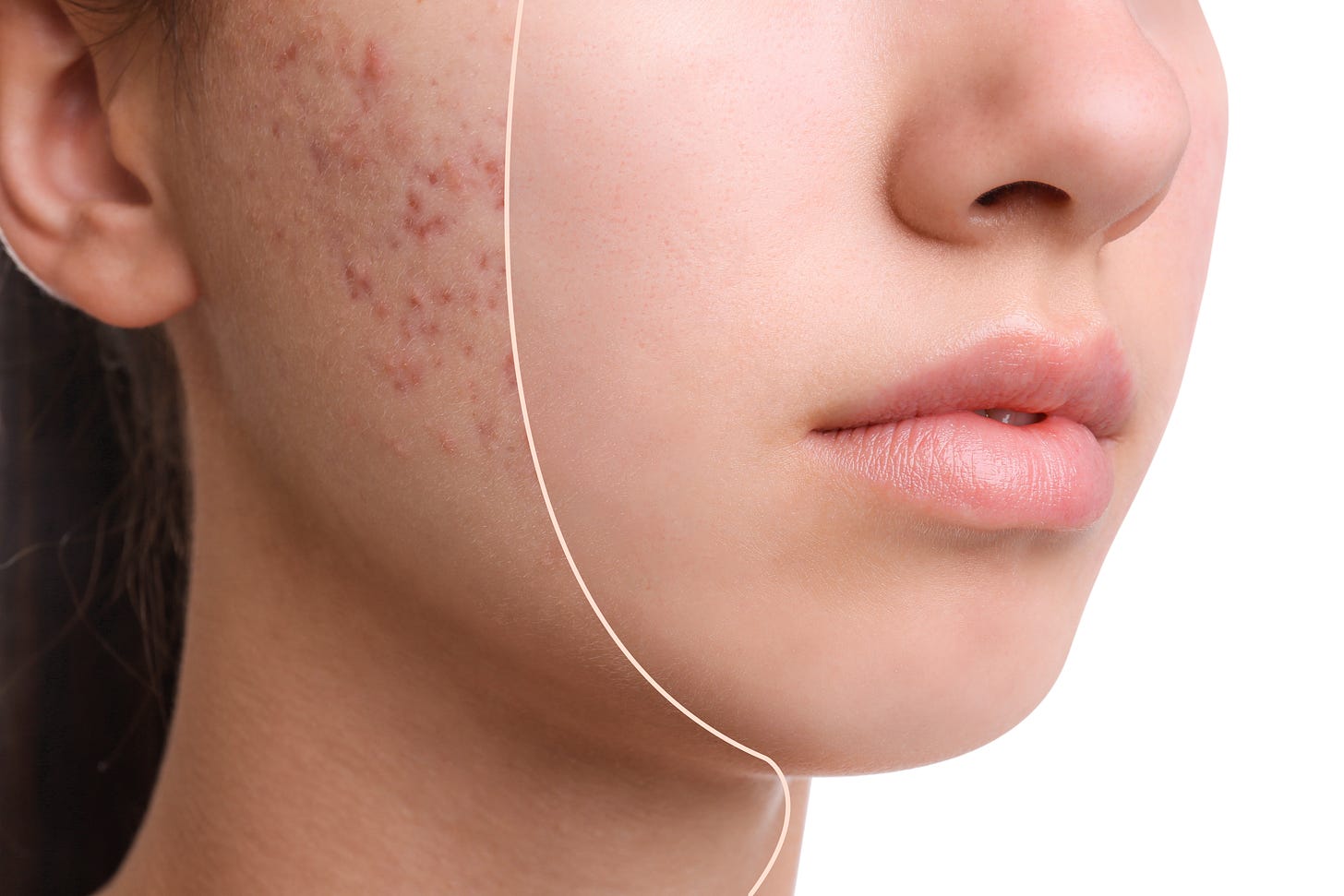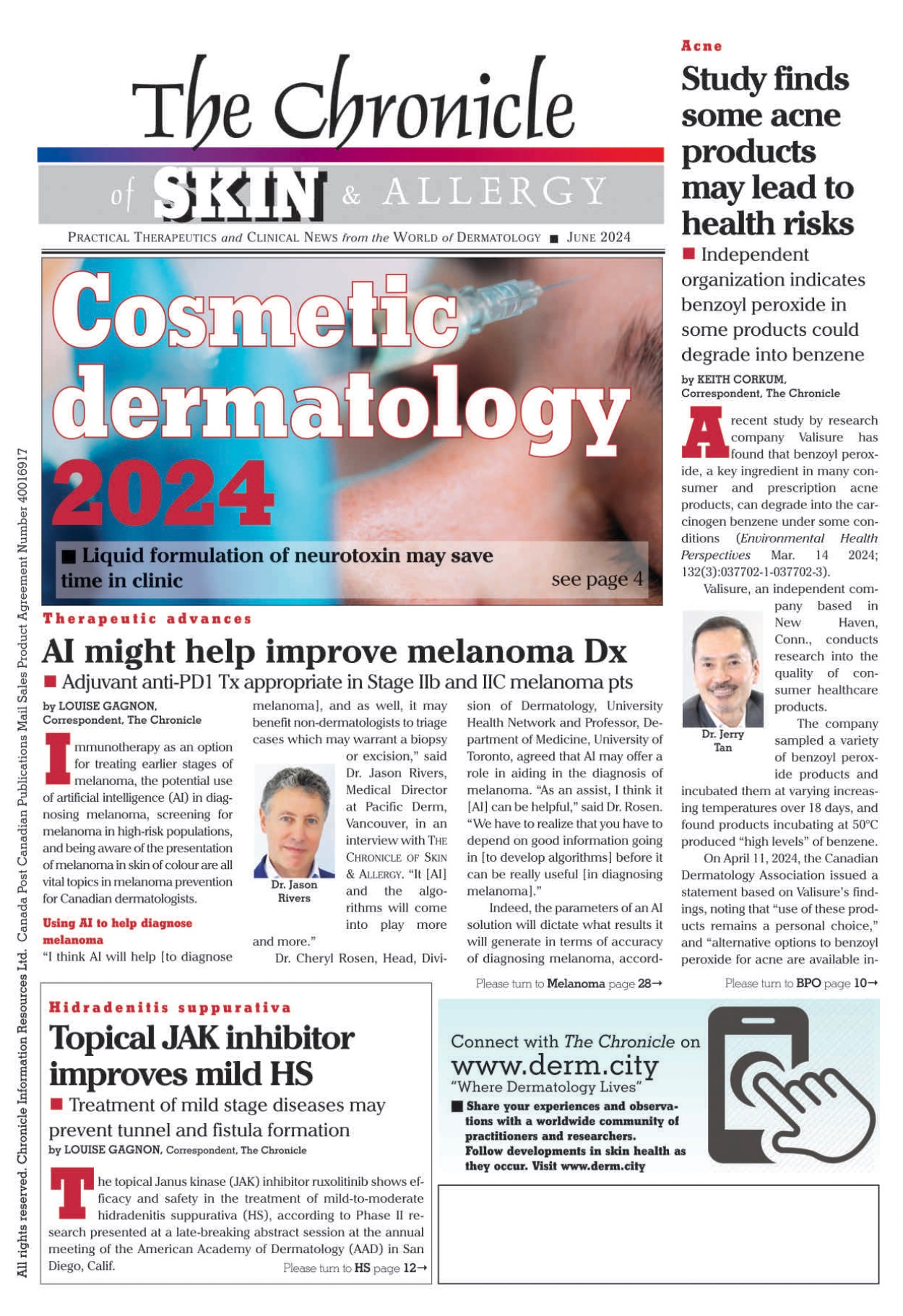Precision cryotherapy effective, safe for acne Tx
Today's report also covers assessing isotretinoin hesitancy, the impact of adolescent acne, dose-response relationships, and more (1,600 words, 7 minutes, 30 seconds)
The Focus on Acne e-newsletter is supported by an unrestricted grant from Sun Pharma Canada
Good morning, and welcome to the tenth issue of Focus on Acne, presented by Skin Spectrum Weekly. This series provides up-to-date information on developing therapies and trends in acne treatment. We appreciate your feedback and suggestions and invite you to be in touch. Please write to us at health@chronicle.org
Precision cryotherapy effective, safe for acne Tx
Findings from a small study show precision cryotherapy effectively improved acne lesions and was safe and satisfactory for participants. The researchers say their results show the potential of this treatment as an alternative therapeutic modality, especially for populations with limited treatment options.
The study was published in Skin Research and Technology (Sept. 2024; 30(9):e70045)
A total of 20 volunteers underwent targeted precision cryotherapy using a carbon dioxide-based device. Researchers assessed treatment outcomes using various parameters, including Investigator Global Assessment (IGA) score, acne lesion count, erythema index (EI), global evaluation score, and participant satisfaction. They also monitored safety through adverse event reporting and physical examination.
Investigators found precision cryotherapy demonstrated a significant reduction (90.25%) in the acne lesion count by week four, with significant clinical improvement (p<0.001). The EI showed notable improvements at weeks one, two, and four. The global evaluation score demonstrated a 75%-100% clinical improvement on the fourth visit. Participants reported high satisfaction (6.75±0.79) with the procedure. The researchers reported no adverse events or discomfort.
In their conclusions, the authors note further research is needed to validate the results and explore underlying mechanisms.
Scale for assessing isotretinoin hesitancy in acne patients developed
Researchers have developed a scale that provides a valid and reliable assessment of isotretinoin hesitancy in acne patients. The authors suggest eliminating isotretinoin hesitancy may reduce acne-related clinical and psychosocial consequences.
In a paper published online ahead of print in the Journal of Cosmetic Dermatology (Sept. 18, 2024), the researchers describe a 22-item scale to assess patient hesitancy related to isotretinoin treatment. They created the scale based on related literature and expert opinions. The items on the scale related to beliefs and worries about isotretinoin were formatted with response options: agree, indecisive, and disagree. In this study, investigators tested construct validity with exploratory factor analysis and reliability with internal consistency and split-half reliability.
The results of exploratory factor analysis indicated a three-factor solution with a total of 14 items, explaining 57% of the total variance. The first factor (Hesitancy Related to Reversible Adverse Effects: 6 items) accounted for 30% of the variance, the second factor (Hesitancy Related to Irreversible Adverse Effects: 4 items) accounted for 16% of the variance, and the third factor (Isotretinoin-related Anxiety: 4 items) accounted 11% of the variance. The internal consistency of the three factors was calculated as 0.79, 0.78, and 0.72, respectively. The Cronbach's alpha score of the total scale was found to be 0.81, and split-half reliability was found to be 0.87.

Adolescent acne does not impact long-term education, labour, or relationship outcomes
Recent findings suggest that acne during adolescence does not affect long-term educational, labour market or relationship outcomes. However, the study authors write that additional research is needed to validate the findings in untreated patients and different health and social systems.
For the paper, published online ahead of print in the Journal of the European Academy of Dermatology and Venereology (Sept. 18, 2024), investigators conducted a nationwide registry-based cohort study in Denmark. They included birth cohorts from 1982 to 1988 and compared those with and without acne identified using hospital diagnosis codes and redeemed prescriptions.
The main educational outcome was educational attainment, the main labour market outcomes were earned income at age 30 and long-term unemployment at any time before age 30, and the main relationship outcomes were single partnership and childlessness by age 30.
Researchers found those with acne had a lower risk of not completing upper secondary education (relative risk (RR): 0.79; 95% confidence interval [CI]: 0.76-0.83) and higher education (RR: 0.90; 95% CI: 0.88-0.91), with absolute differences up to 4 percentage points. Persons with acne had slightly higher income (mean percentile difference: 2.6%, 95% CI: 2.2-2.9) and lower risk of long-term unemployment than those without acne (9.8% vs. 11.4%; RR: 0.90; 95% CI: 0.87-0.93). The prevalence of being single until age 30 was similar (19.7% vs. 20.1%; adjusted RR: 0.96; 95% CI: 0.94-0.98), but childlessness was slightly more prevalent (60.5% vs. 57.5%; adjusted RR: 1.03; 95% CI: 1.02-1.04). However, all associations were attenuated or lost in a secondary analysis restricted to exposure-discordant siblings to address confounding from family-related factors.

Dose-response relationship seen between isotretinoin, IBD
Investigators have identified a dose-response relationship between isotretinoin exposure and inflammatory bowel disease (IBD) risk in a Korean Asian population.
These findings come from a nationwide, population-based, case-control study using the National Health Insurance Service database of South Korea. The study was published in the Indian Journal of Dermatology (July-Aug. 2024; 69(4):301-305).
The study’s case group comprised 107,434 patients with IBD, while the control group comprised 393,830 patients who were matched using a 1:4 propensity score. Researchers extracted data on isotretinoin exposure within the previous five years from the database and performed a multivariable-adjusted, conditional, logistic regression.
After adjusting for age, sex, underlying disease, the Charlson co-morbidity index, and tetracycline use, the authors found a significant association between isotretinoin exposure and IBD, with an odds ratio of 1.20 (95% confidence interval, 1.10-1.30). Furthermore, the association appeared to become stronger with longer exposure, more of a cumulative dose, and a longer time since the first exposure. When analyzed separately for ulcerative colitis and Crohn's disease, isotretinoin exposure was significantly associated with both diseases.
In their conclusion, the authors say that healthcare professionals should be aware of the association and consider alternative medications for acne treatment, particularly in patients who are at a higher risk of developing IBD.

Subscribe to The Chronicle of Skin & Allergy
Established in 1995, The Chronicle of Skin & Allergy is a scientific newspaper providing news and information on practical therapeutics and clinical progress in dermatologic medicine.
To apply for a complimentary* subscription, please email health@chronicle.org with your contact information or click the link below.
If you find the contents of this newsletter interesting, please check out the Yadav on Acne podcast. It’s available at Apple iTunes, Stitcher, Spotify, or wherever you get your podcasts.







